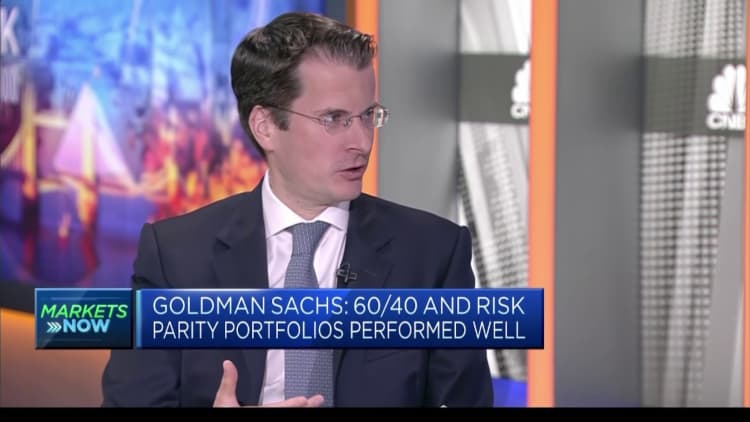Goldman Sachs traders work on the floor of the New York Stock Exchange in New York.
Ramin Talaie | Getty Images
The rapid recovery of market confidence after the dramatic sell-off in global risk assets should be seen as a cause for concern, said the firm’s head of asset allocation research. Goldman Sachs.
Goldman’s Christian Mueller-Grissmann, speaking on CNBC’s “Squawk Box Europe” on Wednesday, said investors could view the stock market crash in early August as something of a “warning bullet.”
The stock market started the month under intense pressure, with stock prices falling from record highs on concerns about a possible U.S. recession and the unwinding of the popular “carry trade” linked to the Japanese yen. The S&P 500 fell 3% on August 5, its biggest one-day drop since 2022.
But since then, stocks have soared on the belief that a Federal Reserve rate cut is imminent and improving U.S. economic data. The S&P 500 has risen 8% since Aug. 5, while the Dow Jones Industrial Average has risen more than 6%.
“Going into this situation, positioning and sentiment had been at the high end of the range for about a month or two. People were bullish,” Mueller-Grissmann said.

“We were actually worried about a bit of a correction because while we remained bullish, macro momentum was weakening a bit. We had had negative U.S. macro surprises for about a month and a half prior to that, and then European and Chinese macro surprises were starting to turn negative,” he added.
“The concern now is how quickly the market has bounced back to where it was before. But it certainly signals that we’re back to pretty much the same issues we had a month ago, unfortunately.”
“A massive technological overreaction”
Market participants are now awaiting the release of a key U.S. inflation report to get a better picture of the health of the world’s largest economy. U.S. personal consumption expenditures price data, the Federal Reserve’s preferred inflation gauge, is due to be released on Friday.
Prior to this, Fed Chairman Jerome Powell said last weekend that “it is time to adjust policy,” raising expectations for a rate cut at the Fed’s meeting on Sept. 18. Chairman Powell refrained from giving specific indications about the timing or size of the rate cut.
Pedestrians walk along Wall Street near the New York Stock Exchange (NYSE) on Tuesday, August 27, 2024 in New York, USA.
Bloomberg | Bloomberg | Getty Images
Asked what risk appetite might look like in the coming months, Mueller-Grissmann said: “What happened on and around August 5 was clearly a technical overreaction, so it was a buying opportunity.”
He said the challenge now for market participants is that stocks and risk assets have “completely reversed” losses and are back to previous levels.
“What I find very interesting is that risk appetite has not returned to previous levels and what has actually happened is that safe havens like bonds, gold, the yen and the Swiss franc have not really been sold off,” Mueller-Grissmann said.
“The good news is that while the S&P has returned to previous levels, we can’t let our guard down. We’re not in the same extremely bullish sentiment or positioning as we were before.”
What’s next for investors?
Mueller-Grismann, a former advocate of the 60/40 portfolio, said balanced portfolios performed “phenomenal” through a volatile month, but he cautioned that the buffer the bond market recently provided may not be all that reliable in the near term.
“If you think about it, the bond market cushioned most of the decline. If you look at the 60/40 portfolio, it was temporary. I think the maximum decline in a balanced portfolio in the U.S. or Europe was 2%. So the bond market balanced out with equities as you would expect,” Mueller-Grismann said.
“Given that you don’t have a huge fixed income buffer right now, you might want to be a little more careful on the risk side strategically, especially after this rally,” he continued.
“There are different ways to address this: cutting back a bit, creating alternative diversification vehicles, liquid alternatives, option overlays, etc.”
—CNBC’s Lisa Kailai Han and Brian Evans contributed to this report.
#Goldman #issued #warning #quickly #market #confidence #recovered #Augusts #stock #market #crash